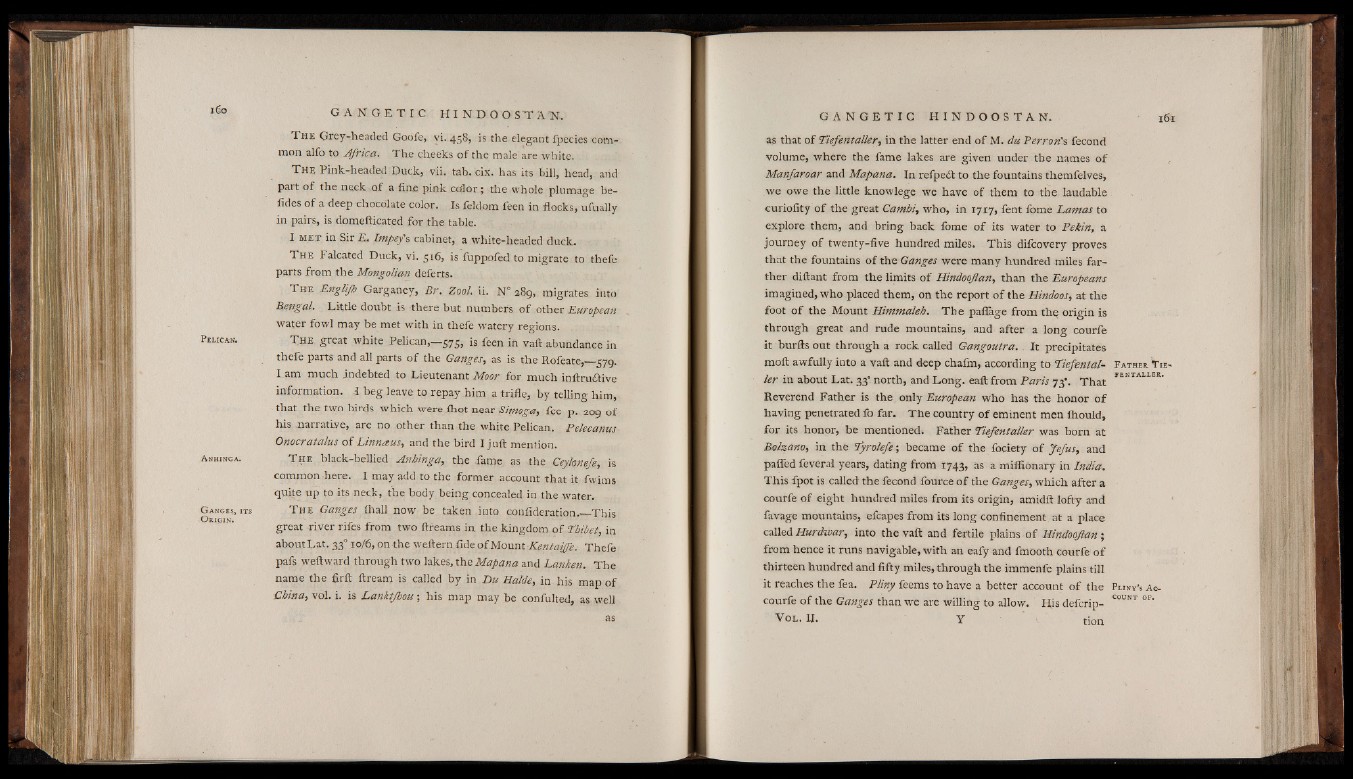
P e l i c a n .
A n h i n c a .
G anges, it s
O r iq in .
T h e Grey-headed Goofe, vi. 4 5®? h the. elegant fpecies common
alfo to Africa. The cheeks o f the male are white.
T he Pink-headed Duck, vii. tab. cix. has its bill, head, and
part o f the neck o f a fine pink color ; the whole plumage be-
fides of a deep chocolate color. Is feldom feen in flocks, xxfually
in pairs, is domefticated for the table.
I m e t in Sir E. Impey's cabinet, a white-headed duck.
T he Falcated Duck, vi. 5x6, is fuppofed to migrate to thefe
parts from the Mongolian defects.
T he Englijh Garganey, Br. Z00L ii. N° 289, migrates into
Bengal. Little doubt is there but numbers of other European
water fowl may be met with in thefe watery regions.
T he great white Pelican,— 575? *s feen in vaft abundance in
thefe parts and all parts o f the Ganges, as is the Rofeate,— 579.
I.am much indebted to Lieutenant Moor for much inftruitive
information. I beg leave to repay him a trifle, by telling him,
that the two birds which were fhot near Simoga, fee p. 209 of
his narrative, are no other than the white Pelican. Pelecanus
Onocratalus of Linnaus, and the bird I juft mention.
T he black-bellied Anbinga, the fame as the Ceyhnefe, is
common here. I may add to the former account that it fwims
quite up to its neck, the body being concealed in the water.
T he Ganges (hall now be taken into coniideration. This
great -river rifesfrom two ftreams in the kingdom o f ‘Thibet, in
aboutLat. 33° 10/6, on the weftern fide oiMounlKentaiffe. Thefe
pafs weftward through two lakes, the Mapana and Lanken. The
name the firft ftream is called by in Du Halde, in his map of
China, vol. i. is Lanktjhou; his map may be confulted, as well
as
as that o f Tiefentaller, in the latter end o f M. du Perron's fecond
volume, where the fame lakes are given under the names of
Manfaroar and Mapana. In refpect to the fountains themfelves,
we owe the little knowlege we have of them to the laudable
curiofity of the great Gamhi, who, in 1717, fent fome Lamas to
explore them, and bring back fome o f its water to Pekin, a
journey o f twenty-five hundred miles. This difcovery proves
that the fountains of the Ganges were many hundred miles farther
diftant from the limits o f Hindoojlan, than the Europeans
imagined, who placed them, on the report of the Hindoos, at the
foot o f the Mount Himmaleb. The paflage from thq origin is
through great and rude mountains, and after a long courfe
it burfts out through a rock called Gangoutra. It precipitates
molt awfully into a vaft and deep chafin, according to Tiefentaller
in about Lat. 33° north, and Long, eaft from Paris 73*. That
Reverend Father is the only European who has the honor of
having penetrated fo far. The country o f eminent men ihould,
for its honor, be mentioned. Father Tiefentaller was born at
Bolzano, in the Tyrolefe-, became o f the fociety o f Jefus, and
palTed feveral years, dating from 1743, as a miflionary in India.
This fpot is called the fecond fource of the Ganges, which after a
courfe of eight hundred miles from its origin, amidft lofty and
favage mountains, efcapes from its long confinement at a place
called Hurdwar, into the vaft and fertile plains o f Hindoojlan;
from hence it runs navigable, with an eafy and fmooth courfe of
thirteen hundred and fifty miles, through the immenfe plains till
it reaches the fea. Pliny feems to have a better account of the
courfe of the Ganges than we are willing to allow. His defcrip-
V ol. II. y ' 1 tion
F a t h e r . T i e -
F EN TA L LER .
Pl in y ’s A ccount
of.